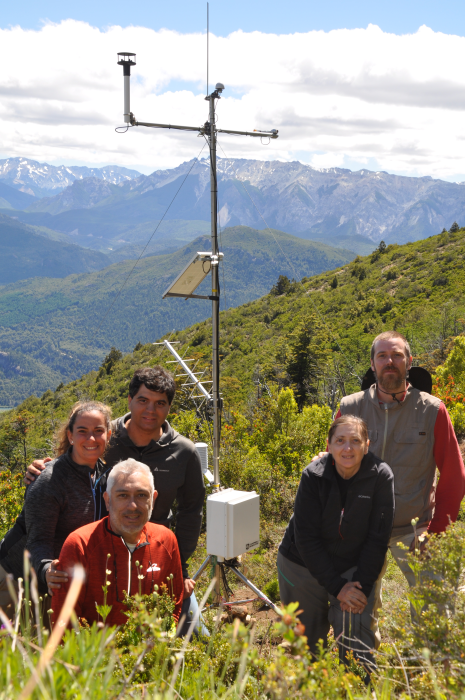



はじめに
アルゼンチンのアンデス山脈は、多種多様な有機生命体の生息地です。気候変動は世界の山岳地帯に影響を及ぼしており、これらの種を危険にさらす可能性があります。ブエノスアイレス大学 (UBA) の大気海洋科学部の生物気象学チームは、この生命が存在できる条件を研究しています。取得した測定値には、気温と相対湿度、全天日射量、葉の湿り具合、風速と風向が含まれます。アンデス地域の険しく過酷な性質のため、UBA は、CR300 データロガー、TX321 GOES トランスミッター、ダックビル アンカー キット付き CM110 三脚、ENC16/18 エンクロージャー、HMP155A 温度および相対湿度センサー、WindSonic4 2-D 風速センサーなど、このプロジェクトに不可欠な機器の提供に Campbell Scientific を選択しました。
生物学的エアロゾル
生物エアロゾルの輸送を理解することは、気候変動の将来とアンデスの野生生物の変化にとって重要です。エアロゾルは、空気中に拡散する小さな固体または液体の粒子です。生物エアロゾルは、微生物、植物、または動物に由来するエアロゾルです。生死を問わず病原性または非病原性の細菌、真菌、その他の生物で構成される生物エアロゾルは、周囲の環境に影響を及ぼします。アンデス全域にわたるこれらの生物エアロゾルの拡散を測定することは、野生生物の保護と将来の気候変動の監視に大きな影響を与える可能性があります。
野生生物に対するエアロゾルの重要性
アンデスのさまざまな野生生物は、花粉やその他の粒子などの生物学的エアロゾルに依存して繁栄しています。時間の経過とともに気象パターンが変化すると、これらのエアロゾルの拡散が変化し、パタゴニア地域の野生生物と全体的な気候に影響を与えます。生物学的エアロゾルが最も効果的に拡散する気象条件を特定することは、測定を計画する上で不可欠でした。生物学的エアロゾルがどのように拡散するかをより深く理解することで、科学者は地域内の樹木や野生生物の繁殖を促進することができます。
花粉は顕花植物の受精に不可欠です。アンデスの森林では、花粉は樹木が従う自然のサイクルを助け、多くの種の繁栄を可能にしています。花粉は軽くて乾燥しているため、気象条件に非常に影響を受けやすいです。風速と風向を測定すると、植物の受精の傾向を特定するのに役立ちます。研究者はこれらの測定値を使用して、花粉がどこまで移動するかを判断します。相対湿度の測定も実用的な洞察を提供します。空気中の水分は花粉を重くし、種子生産を減らす可能性があるためです。
アンデスでデータを取得するには、独特の課題があります。これらの測定は、南米最長の山脈の遠隔地で行われます。南アンデスは、湿度の高い山岳気候です。強風、急激な気温の変化、突発的な雨、雪などにより、極端な状況になることが多々あります。
異常気象に加え、地質学的障壁も研究者がアンデスで活動することを困難にしています。アンデスの森林の多くは人里離れており、道路や小道などの入口からアクセスできません。自動気象ステーションの設置オプションを最大限にするには、研究者は不安定な地形でも簡単に運搬して組み立てられる装置が必要です。このため、Campbell Scientific の CM110 三脚とダックビル アンカー キットが最適な選択でした。また、装置の電力要件が低く、ポータブル ソーラー パネルで効果的に電力を供給できることも重要です。Campbell Scientific の装置は過酷な条件でも動作するという評判があり、HMP155A 気温および相対湿度センサーや可動部品のない WindSonic4 ソニック風速センサーなど、この環境での測定センサーとして理想的な選択でした。
結論
さまざまな気象条件における生物学的エアロゾルの拡散についてさらに学び、測定することは、UBA の大気海洋科学部の生物気象学チームにとって極めて重要でした。過酷な環境と正確な測定の必要性には、頑丈な Campbell Scientific の機器が最適でした。この機器は、タスクを完了するのに十分な耐久性があり、科学者が樹木の再生と森林の害虫や病気の蔓延に対する気象学の関連性を理解する上で極めて重要な役割を果たします。
ケーススタディの概要
アプリケーション
アンデス高地の森林の繁殖戦略に関連する山岳気象条件の測定場所
リオネグロ、アルゼンチン使用製品
CM110 WINDSONIC4-L HMP155A-L TX321 CR300 ENC16/18参加団体
ブエノスアイレス大学(UBA)大気海洋科学部(DCA)生物気象学研究チーム計測項目
気温と相対湿度、全天日射量、葉の湿り具合、風速と風向関連ウェブサイト
Biological Aerosols Pollen Definition Andes MountainsPDFで見る